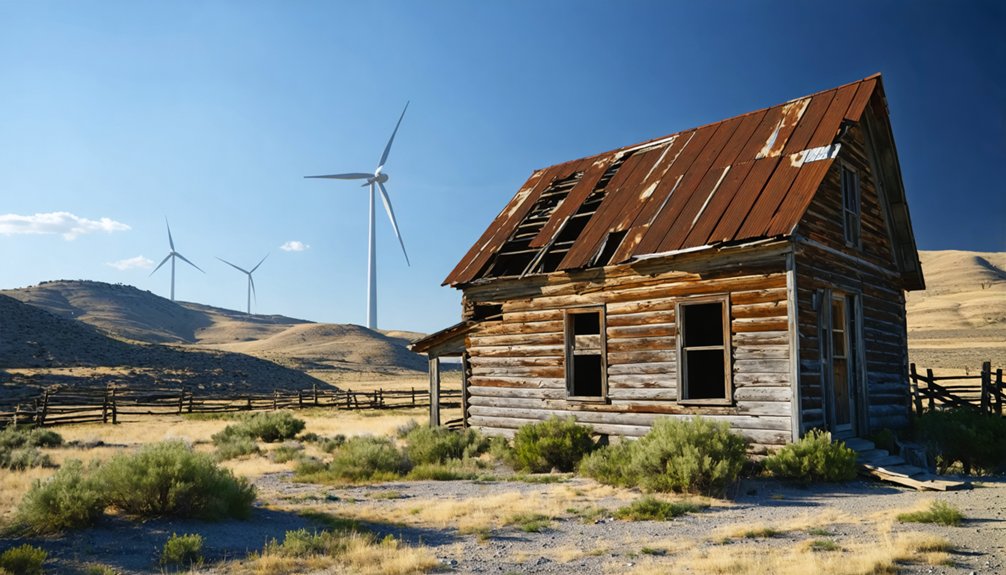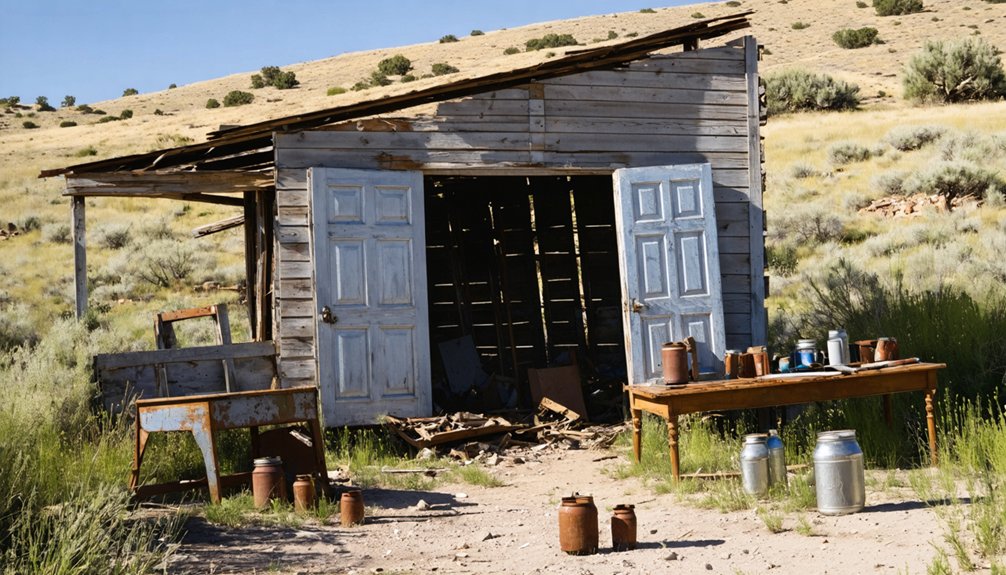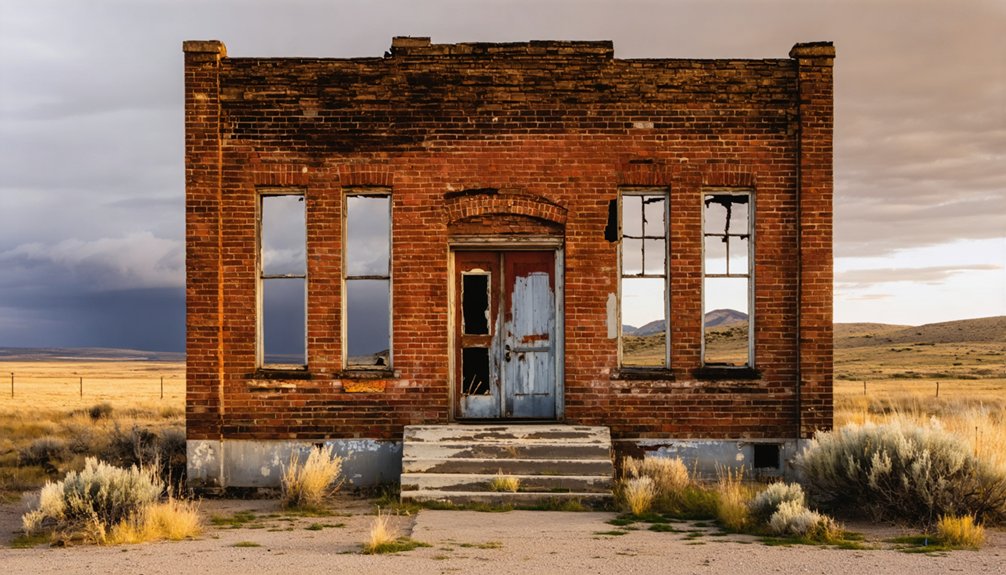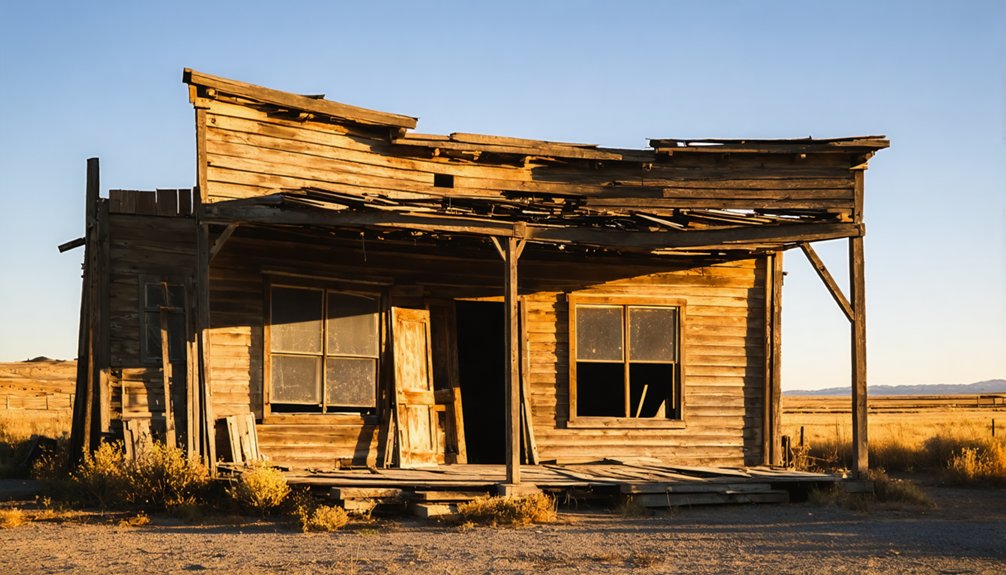You’ll find Cleveland, Idaho’s ghost town in Franklin County, where Mormon pioneers first settled in the mid-1800s. This once-thriving agricultural community featured a general store, post office, and schoolhouse, with life centered around farming and LDS church activities. A devastating 1992 wildfire consumed over 24,580 acres and many original buildings, accelerating the town’s abandonment. The sage-covered hills now hold tales of pioneer resilience and the challenges that shaped southeastern Idaho’s settlement history.
Key Takeaways
- Cleveland was established as a Mormon settlement in Idaho Territory, becoming a self-sustaining community centered around agriculture and religious values.
- The town featured essential buildings including a general store, post office, bank, LDS church, and schoolhouse serving the local population.
- Agricultural activities focused on wheat, barley, and livestock farming, with cooperative practices helping sustain the community for decades.
- Population decline began in the 1950s due to rural exodus, followed by a devastating 1992 wildfire that destroyed original buildings.
- Cleveland now stands as a ghost town, exemplifying the fate of similar rural Mormon settlements in southeastern Idaho that couldn’t maintain sustainability.
A Mormon Settlement Takes Root
As Mormon pioneers sought refuge from persecution in the mid-1800s, they began establishing settlements across Idaho Territory.
You’ll find that their early settlement patterns reflected both practical needs and religious motivations, with communities strategically placed near water sources for irrigation farming.
The Mormon migration into Idaho gained momentum after earlier attempts like Fort Lemhi, established in 1855, faced challenges with native tribes.
By 1859, settlers successfully founded Franklin, Idaho’s first permanent Mormon community, though they initially thought they were still in Utah Territory.
The settlements provided safe havens where Mormons could practice their faith while building self-sustaining communities.
They established organized wards and stakes, created schools, and adapted their proven agricultural techniques to Idaho’s unique environment, all while maintaining strong ties to their Utah-based church leadership.
Led by Charles Rich, Mormon settlers went on to establish Paris Tabernacle site after fifteen years of dedicated community effort.
Just as they had done during the Kirtland Era growth, these pioneers focused on building strong religious communities centered around their faith.
Life in Early Cleveland
Life in Cleveland during its early years centered around the daily rhythms of agricultural work and Mormon community values. You’d find settlers working their fields with basic tools, trading with nearby towns like Franklin and Clifton, and gathering regularly for religious services. The harsh semi-arid climate shaped daily life, requiring adaptability as seasons changed.
Like many Mormon settlements established in the 1860s after Fort Lemhi’s abandonment, Cleveland’s pioneers drew on lessons from earlier settlement attempts. Early settlers often gathered at Dunham Tavern, one of the region’s oldest buildings, to discuss community matters and share meals.
During winter’s cold grip, you’d join neighbors in community gatherings, sharing stories and preserving food stocks.
Come spring, you’d plow fertile fields alongside fellow settlers, your success tied to the land’s abundance.
Summer’s warmth would bring harvest festivals, strengthening cultural traditions and community bonds.
In autumn, you’d trade crops with nearby settlements, building essential economic relationships that sustained your freedom.
The community’s self-sufficiency and strong cultural traditions created a resilient foundation for survival in this challenging frontier environment.
Community Landmarks and Gathering Places
The heart of Cleveland’s social fabric took shape around several key gathering places that defined daily community life. You’d find residents congregating at the general store to exchange news and supplies, while the post office served as an essential communication hub.
Similar to the Federal Reserve Bank’s massive vault door, the town bank’s imposing entrance symbolized security and economic stability for the community.
The LDS church anchored religious and social functions, hosting community gatherings that strengthened local bonds. Like other mining settlements during the 1860s gold rush, Cleveland emerged as one of many boomtowns dotting Idaho’s landscape.
As the spiritual cornerstone of Cleveland, the LDS church brought people together through both worship and social connection.
For recreation, the swimming pool drew people together during warmer months, and the baseball team sparked town pride in the early 1900s.
The schoolhouse’s historical significance extended beyond education, doubling as a venue for town events.
Though many original structures have burned down, remnants like sidewalks and railroad station ruins still tell the story of Cleveland’s bustling past, while the cemetery preserves the community’s deeper connections to its pioneer heritage.
Education and Social Development
While pioneering families settled Cleveland in the early 1900s, they quickly established educational foundations through a schoolhouse that served local children until the 1950s. Located 13 miles north of Preston, the town became an important educational center for the surrounding region.
The school was part of a vibrant hub of community education that included a post office, store, LDS church, and swimming pool, fostering social cohesion among residents. Similar to Tramway School, the institution served as a vital gathering place for local families.
- You’ll find archived teacher and student rosters revealing a structured learning environment where local children gained essential knowledge.
- You can imagine the excitement of baseball games that united youth and strengthened bonds between neighboring towns.
- You’ll understand how the school served as more than just classrooms – it was the heart of community gatherings.
- You’ll discover how population shifts after WWII gradually eroded these educational and social foundations, leading to the school’s eventual closure.
Agricultural Heritage and Economic Activities
Settling in Cleveland’s challenging alkaline soil conditions, pioneering farmers established a robust agricultural community in the late 19th century that would shape the region’s economic identity for decades to come.
Mormon settlers introduced sustainable practices focused on mixed farming, raising both crops and livestock to guarantee self-sufficiency. Like the settlers of ghost town Chesterfield, Cleveland’s Mormon farmers brought their traditional agricultural knowledge to build a thriving community.
Similar to Era’s success with its silver horn mine, Cleveland’s early prosperity relied heavily on natural resource extraction alongside farming activities.
You’ll find that cooperative farming defined Cleveland’s agricultural landscape, with farmers sharing equipment and coordinating irrigation efforts. They grew wheat and barley while raising cattle and sheep, creating a diverse agricultural economy.
The community’s success relied heavily on innovative transport solutions – you could spot grain-filled buckets moving along tramways to nearby rail stations, connecting Cleveland’s produce to broader markets.
Despite implementing drainage programs in 1921 to combat soil issues, these environmental challenges eventually contributed to the area’s economic decline.
Baseball, Swimming, and Local Recreation
If you’d visited Cleveland in the early 1900s, you’d have found a lively baseball scene where the local team regularly faced off against rivals from Thatcher, Perry, Treasureton, and other nearby communities.
The town’s unique swimming pool provided welcome relief during hot Idaho summers, making Cleveland one of the few rural mining communities to offer such a modern recreational amenity.
These facilities, along with church gatherings and school functions, created strong social bonds that kept the community vibrant through its peak years before declining in the 1950s.
Community Baseball Rivalries
During the early 1900s, Cleveland’s local baseball team emerged as a cornerstone of community life, regularly competing against neighboring towns like Thatcher, Perry, Treasureton, Mink Creek, Niter, and Grace.
These local rivalries fostered intense community bonding throughout Franklin County, as teams faced off on communal and school fields. You’ll find that baseball served as one of the few organized recreational activities in this rural region.
- Players like Levi Meservey and Leonard Hoopes represented Cleveland’s fighting spirit on the diamond.
- Games brought entire communities together, transcending mere sport to become social events.
- Local rivalries created lasting connections between neighboring towns.
- Baseball traditions helped preserve town identity even as population declined in the 1950s.
Swimming Pool Summer Activities
The community swimming pool emerged as Cleveland’s vibrant summer hub, where locals gathered for recreation and social events throughout the warmer months.
You’d find families enjoying pool parties and social gatherings while children splashed in the cool water during Idaho’s hot summers. The facility hosted various activities, likely including swimming competitions and summer camps that brought the community together.
As Cleveland’s population declined in the 1950s, so did the pool’s infrastructure.
Despite local residents’ efforts to maintain this cherished recreational facility, many of the original structures eventually burned down.
Today, you’ll only find remnants of what was once a cornerstone of Cleveland’s summer social life, with manufactured homes now dominating the landscape where children once played and communities once thrived.
The Path to Abandonment

Cleveland’s transformation into a ghost town began with its population decline in the 1950s, as rural families moved away from small farming communities across southeastern Idaho.
You’ll find that most of Cleveland’s original buildings were lost to fires over the years, leaving only a few manufactured homes and the remnants of the community swimming pool.
The agricultural way of life that once sustained this close-knit community gradually faded away as improved transportation made larger towns more accessible and farming practices evolved.
Population Decline After 1950s
As mining towns across the American West struggled with post-war economic shifts, Idaho’s Cleveland began its steady march toward abandonment in the 1950s.
Population trends showed a dramatic exodus as residents faced the harsh realities of a changing economy. The rural migration hit Cleveland particularly hard, with younger families seeking opportunities in urban areas while aging residents remained behind.
- You’d have witnessed the closure of the mines that once sustained the community, as automation and new technology made manual labor increasingly obsolete.
- Your neighbors would have gradually disappeared as essential services – stores, schools, and medical care – vanished.
- You’d have seen property values plummet while abandoned buildings dotted the landscape.
- Your community’s social fabric would have unraveled as long-time residents either passed away or relocated.
Fire Destroys Original Buildings
During late September 1992, a devastating wildfire swept through Cleveland, forever altering the town’s physical landscape and hastening its change to ghost town status.
What began as a quarter-acre blaze near Riverton quickly exploded into a 24,580-acre inferno, with flame lengths reaching 100 feet. You’d have seen over 500 firefighters battling the blaze for five days before achieving containment on October 4.
The fire aftermath proved catastrophic for Cleveland’s remaining infrastructure. Original buildings that had survived previous fires succumbed to this decisive blaze, erasing vital pieces of the town’s mining heritage.
The community loss extended beyond physical structures – with essential buildings destroyed, rebuilding costs proved prohibitive for the declining population. Like other Idaho mining settlements that faced similar fates, the 1992 fire marked Cleveland’s final change into abandonment.
Agricultural Community Fades Away
Well before the devastating 1992 fire, agricultural decline had already begun reshaping Cleveland’s destiny. You’ll find that the community’s struggle with agricultural innovation mirrored many Idaho settlements facing similar challenges. The region’s alkaline soils and limited water resources gradually wore down the economic resilience of local farmers.
- Your ancestors watched helplessly as market prices plummeted, making it impossible to sustain their family farms.
- You’d have seen the exodus of young talent to urban areas, leaving fewer hands to work the land.
- Your community’s isolation meant limited access to modern farming techniques and resources.
- You would’ve witnessed the gradual withdrawal of essential services, making daily life increasingly difficult.
The agricultural decline proved insurmountable, transforming a once-thriving farming community into another Idaho ghost town.
Remaining Traces and Modern Views

Today’s Cleveland, Idaho bears little resemblance to its former self, with only scattered remnants hinting at its past existence. As you explore this ghost town, you’ll find fragments of the community swimming pool and a few manufactured homes, but most structures have vanished.
The post office, school building, and LDS church have all disappeared, leaving behind an eerie landscape of historical significance.
Nature has reclaimed much of the area, with vegetation overtaking the abandoned sites. Fire damage, harsh weather, and decades of neglect have taken their toll on what’s left.
While the town doesn’t attract as many visitors as other Idaho ghost towns like Silver City, you can still experience its haunting atmosphere along Idaho State Road 34, where the surrounding natural beauty contrasts sharply with the remnants of this once-thriving community.
Legacy in Franklin County History
Cleveland’s role in Franklin County’s historical tapestry illustrates the complex patterns of pioneer settlement and rural decline that shaped southeastern Idaho. Unlike the enduring town of Franklin, Cleveland’s history reflects a more common narrative of rural communities that couldn’t sustain their initial promise.
- You’ll find Cleveland’s cultural significance deeply rooted in its once-thriving baseball team and school, which fostered community pride and local identity.
- You can trace the town’s pioneering spirit through its early self-sufficiency, with its own store, post office, and unique public swimming pool.
- You’re witnessing the lasting impact of LDS influence that defined the social fabric of southeastern Idaho settlements.
- You’re able to understand broader regional patterns through Cleveland’s story, as it mirrors the fate of other ghost towns like Coulam and Rushville.
Frequently Asked Questions
Are There Any Paranormal Activities Reported in Cleveland’s Remaining Structures?
Like a silent wilderness devoid of footprints, you won’t find documented ghost sightings or haunted locations in Cleveland’s structures. Other Idaho ghost towns claim paranormal activity, but Cleveland’s ruins remain spiritually quiet.
What Was the Peak Population of Cleveland During Its Most Prosperous Years?
You won’t find exact peak population records, but considering the town’s economic factors and population growth patterns in similar Idaho farming communities, estimates would likely place Cleveland’s heyday numbers in the low hundreds.
Can Visitors Legally Explore the Cleveland Ghost Town Site Today?
Due to limited available records about visitor access and legal regulations, you’ll need to check with Custer County or the Bureau of Land Management for current rules about exploring these ruins.
Were There Any Notable Crimes or Incidents That Contributed to Cleveland’s Decline?
Like pages from a pristine diary, Cleveland’s decline factors reveal no documented crime history – the town’s fade mirrored other rural communities facing economic changes and population shifts in mid-1900s Idaho.
What Natural Disasters, if Any, Affected Cleveland Throughout Its History?
You won’t find earthquake impacts or flood damage in Cleveland’s history – fires were the only major destructive force, destroying multiple original structures and contributing to the town’s eventual abandonment.
References
- http://www.franklincountyhist.org/cleveland.html
- https://yellowpinetimes.wordpress.com/2019/01/13/idaho-history-jan-13-2019/
- https://dustywindshield.wordpress.com/2023/04/07/ghost-towns-along-the-clearwater-river-highway-12/
- http://www.franklincountyhist.org/communities.html
- https://history.idaho.gov/wp-content/uploads/2018/08/0064.pdf
- https://visitidaho.org/things-to-do/ghost-towns-mining-history/
- https://idaho-forged.com/idahos-ghost-towns-eerie-yet-approachable/
- https://en.wikipedia.org/wiki/List_of_ghost_towns_in_Idaho
- https://dustywindshield.wordpress.com
- https://case.edu/ech/articles/m/mormons



